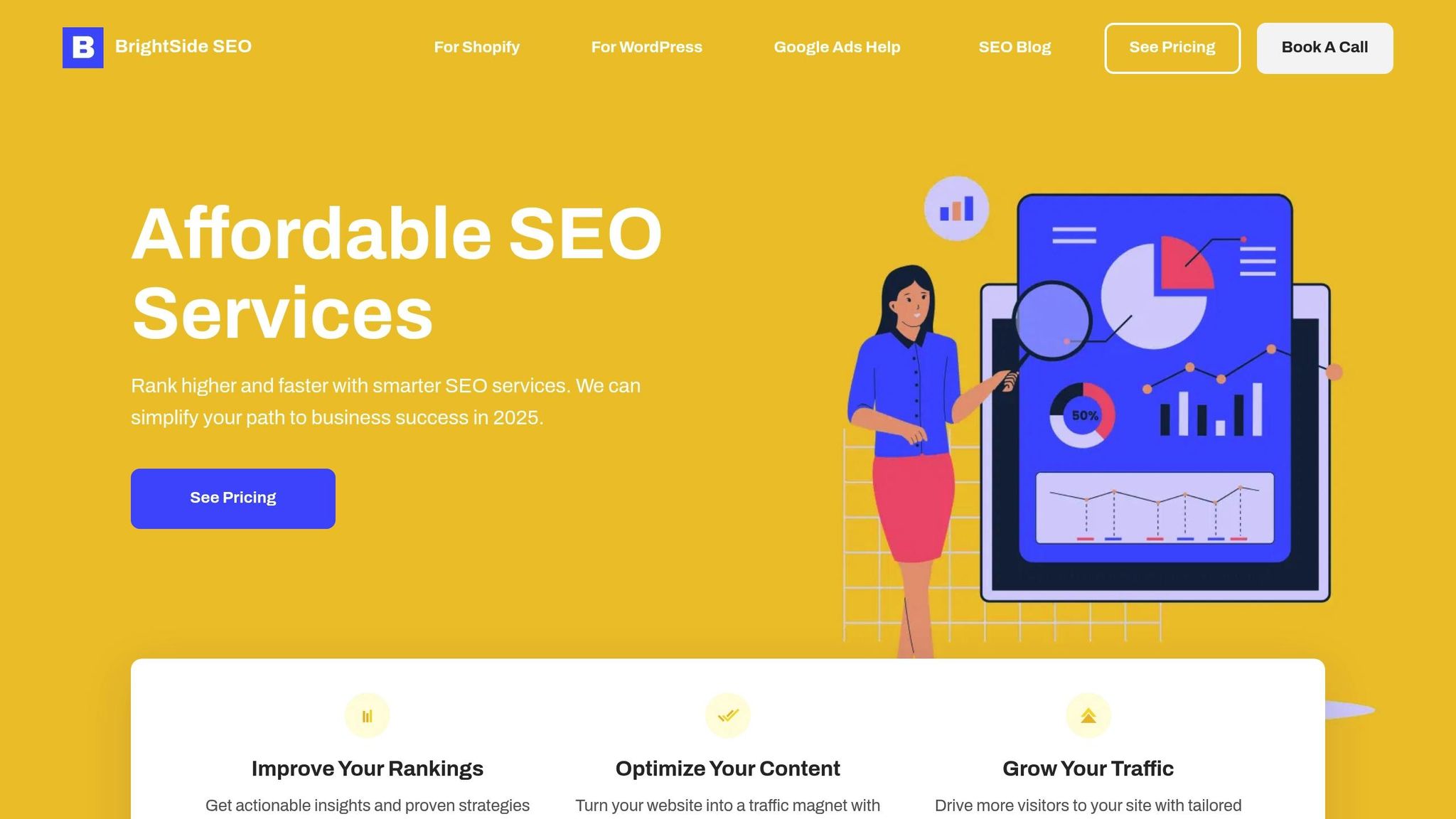Want SEO to drive real business growth? Here's the secret: Align your SEO strategy with your business goals. It's not just about rankings or traffic - it's about measurable outcomes like revenue, market share, and customer acquisition.
Key Steps to Align SEO with Business Goals:
- Define Clear Objectives: Set measurable business goals like increasing sales by 25% or entering new markets.
- Prioritize Goals: Focus on high-impact, resource-efficient targets using a prioritization matrix.
- Set SMART SEO Goals: Make goals Specific, Measurable, Achievable, Relevant, and Time-bound.
- Track Key Metrics: Monitor organic traffic, conversion rates, and revenue from SEO efforts.
- Build a Focused Plan: Research target keywords, create conversion-driven content, and optimize your site technically.
- Measure and Adapt: Use tools like Google Analytics to track progress and refine your strategy monthly.
Quick Tip: Target the right audience, not just more visitors. This ensures higher conversions and ROI from your SEO efforts.
How to Set SMART SEO Goals & Objectives in 2025?
Identify Your Business Goals
Define your business goals clearly to ensure your SEO strategy aligns with overall growth plans.
Outline Key Business Objectives
Start by identifying the main goals for your business:
- Revenue targets: For example, "boost online sales by 25% in the next 6 months."
- Market expansion: Enter new regions or reach specific demographics.
- Customer acquisition: Set goals for gaining new customers and managing acquisition costs.
- Brand visibility: Define specific metrics to increase brand recognition.
- Customer retention: Focus on improving repeat purchases and customer lifetime value.
Make sure these objectives are measurable. Instead of saying, "grow the business", aim for something like, "increase monthly recurring revenue from $100,000 to $150,000 by the end of Q4 2025."
Once your goals are outlined, work with your team to refine and prioritize them.
Collaborate with Decision Makers
Engage key stakeholders, including executives, sales leaders, marketing teams, product managers, and customer service representatives. These discussions will help you understand the bigger picture, including challenges and resource limitations.
Focus on these areas during your meetings:
- Current business challenges
- Growth targets for the next 12-18 months
- Key customer segments
- Performance metrics (KPIs)
- Available resources and potential constraints
Rank Your Business Goals
Not every goal carries the same weight. Use a structured approach to prioritize effectively:
1. Business Impact
Assess how each goal could influence:
- Revenue growth
- Market positioning
- Customer satisfaction
- Operational efficiency
2. Resource Requirements
Evaluate the resources each goal demands, such as:
- Budget
- Team capacity
- Technical needs
- Time constraints
3. Implementation Complexity
Consider factors like:
- Technical challenges
- Coordination across departments
- Need for external vendors
- Compliance or regulatory hurdles
Use a prioritization matrix to organize your goals:
| Priority Level | Time Frame | Impact Level | Resource Need |
|---|---|---|---|
| Critical | 0-3 months | High ROI | Immediate allocation |
| Important | 3-6 months | Medium ROI | Planned allocation |
| Secondary | 6-12 months | Low ROI | As available |
This method ensures your SEO strategy targets the most impactful goals while staying realistic about resources and constraints.
Create SMART SEO Goals
Once you've identified your business objectives, the next step is to set SMART goals to align with them. SMART stands for Specific, Measurable, Achievable, Relevant, and Time-bound - a framework that ensures your goals are clear and actionable.
Align SEO Goals with Business Objectives
Transform your business priorities into SEO targets that deliver quantifiable outcomes. Here's how SEO goals can support broader business objectives:
| Business Goal | SEO Goal | Key Success Metrics |
|---|---|---|
| Increase online sales by 25% | Drive 40% more organic traffic to product pages | Organic traffic, conversion rate, revenue from organic search |
| Enter new market segment | Rank in the top 3 for location-specific keywords | Local search visibility, geographic traffic distribution |
| Improve brand awareness | Boost branded search volume by 35% | Brand mentions, direct traffic growth |
Identify Key Metrics for Tracking Success
Pick performance metrics that directly reflect progress toward your SEO and business goals.
-
Primary Metrics: These core indicators tie directly to revenue and growth:
- Organic traffic to key pages
- Revenue generated from organic search
- Goal completion rates (e.g., purchases, form submissions)
- Average order value from organic visitors
- Lead quality for SEO-driven leads
-
Supporting Metrics: These help assess the overall health of your SEO efforts:
- Rankings for high-priority keywords
- Click-through rates (CTR) from search results
- Page load times
- Core Web Vitals performance
- Backlink quality and growth
Set Time-Based Milestones
Assign deadlines to your SEO goals to maintain focus and momentum. Break down long-term targets into smaller, manageable milestones.
Q2 2025 Milestones:
- Complete a technical SEO audit and resolve critical issues
- Optimize the top 20 pages contributing to revenue
- Add schema markup to all product pages
Q3 2025 Milestones:
- Increase organic traffic to product pages by 15%
- Improve average rankings for target keywords by 5 positions
- Lower bounce rates on key landing pages by 20%
Q4 2025 Milestones:
- Achieve a 25% boost in organic conversions
- Secure top 3 rankings for 60% of priority keywords
- Grow non-branded organic traffic by 30%
sbb-itb-d7fe25c
Build Your SEO Plan
Create an SEO strategy that aligns with your business goals. Focus on these essential components:
Research Target Keywords
Find keywords that match your audience's search intent and support your business objectives. Prioritize keywords that:
- Reflect customer search behavior at different stages of their buying journey.
- Have competition levels suitable for your domain's authority.
- Indicate clear commercial value.
A focused 3-hour SEO workshop ($399) can help uncover high-return keywords.
Use these insights to develop content that not only attracts traffic but also drives conversions.
Write Content That Converts
Produce content that appeals to both search engines and your audience by focusing on these elements:
| Content Component | Business Goals | SEO Benefits |
|---|---|---|
| Clear Value Proposition | Solves specific customer problems | Boosts relevance for search |
| Actionable Solutions | Encourages conversions | Improves engagement metrics |
| Effective Calls-to-Action | Directs users to take desired steps | Supports conversion optimization |
| Industry Expertise | Establishes trust and credibility | Enhances topical authority |
Use clear headings and schema markup to structure your content.
Once your content is ready, tackle technical challenges with proper site optimization.
Implement Technical SEO
Technical SEO ensures your website delivers content effectively to both users and search engines. Focus on these areas:
1. Core Technical Elements
- Ensure a responsive design with fast loading times.
- Use HTTPS for secure browsing.
- Maintain a clean and simple URL structure.
2. Schema Implementation
- Optimize schema for product pages, service descriptions, business details, and customer reviews.
3. Quality Link Building
- Build links from relevant industry websites.
- Focus on pages that drive conversions.
- Regularly monitor link quality.
BrightSide SEO's Starter Plan ($799/month) offers comprehensive schema optimization to enhance your site's performance.
Measure and Improve Results
Keeping tabs on your SEO performance is essential to ensure it supports your business goals. Here’s how you can effectively monitor and refine your results:
Set Up Performance Tracking
Use tools like Google Analytics and Search Console to monitor the metrics that matter most to your business. Prioritize data that ties directly to your goals:
| Metric Type | Business Goal | Key Data Points |
|---|---|---|
| Traffic Quality | Lead Generation | Bounce Rate, Time on Site, Pages per Session |
| Conversion Data | Sales Growth | Goal Completions, eCommerce Revenue, Form Submissions |
| Search Visibility | Brand Awareness | Click-Through Rate, Average Position, Featured Snippets |
| Technical Health | User Experience | Core Web Vitals, Mobile Usability, Crawl Stats |
Custom dashboards can make tracking easier. For example, BrightSide SEO's Starter Plan offers monthly reporting tailored to track up to 10 priority keywords aligned with your business objectives.
Review Monthly Progress
Evaluate your SEO performance each month to identify trends and areas for improvement:
1. Analyze Key Metrics
Compare current data with past performance to spot patterns. Focus on:
- Growth in organic traffic
- Conversion rates from search traffic
- Revenue generated through SEO
- Rankings for your target keywords
2. Assess Content Performance
Look at how individual pages are performing. Pay attention to:
- Pages driving the most conversions
- High-traffic content
- Pages with declining metrics
- Newly published content
3. Check Technical Health
Ensure your site's foundation is solid by monitoring:
- Core Web Vitals scores
- Mobile usability reports
- Page speed metrics
- Adherence to technical SEO best practices
These insights will guide the next steps in fine-tuning your strategy.
Update Your SEO Tactics
Use the data from your monthly reviews to make targeted improvements:
1. Optimize Content
Fix underperforming pages that have potential by:
- Updating outdated information
- Refining keyword focus
- Adding schema markup
- Improving calls-to-action
2. Fix Technical Issues
Address technical problems that could hurt performance:
- Solve mobile usability errors
- Boost page load speeds
- Improve internal linking structure
- Update your XML sitemap
3. Adjust Your Strategy
Adapt your approach to align with changing business needs:
- Focus on keywords with higher conversion potential
- Shift content topics to meet market demands
- Allocate resources to the most effective channels
- Update tracking to reflect new objectives
If you’re looking for expert guidance, BrightSide SEO offers a 3-Hour SEO Work Camp for $399 to help identify quick wins and create an action plan. Their Starter Plan ($799/month) provides ongoing optimization and detailed reporting to keep your SEO efforts on track and delivering results.
Conclusion
To make the most of your SEO efforts, it's crucial to integrate, track, and fine-tune them regularly. Connecting SEO with your business goals requires careful planning, consistent monitoring, and ongoing tweaks. When done right, it can lead to impressive results - like increasing traffic by over 50% and boosting sales by 30% in just a few months.
This alignment works by focusing on targeted keywords, high-quality content, and technical improvements, all of which directly support business growth. Keep your attention on the metrics that impact your goals, whether it’s generating leads, driving sales, or building brand awareness.
Tracking performance is key. Use monitoring tools to evaluate both SEO metrics and business KPIs, ensuring they stay aligned. As markets shift and goals evolve, your SEO strategies should adapt to stay effective.
"Jeremy was flexible, knowledgeable, and actionable. He walked me through steps I should update including adding reviews and updating my email marketing to a different provider. Jeremy sat alongside me as I implemented many of these changes, he also took the time to create a few flows for me as well."
– Michelle Smith, Owner of Gather Goods Co.
This testimonial from Michelle Smith demonstrates how a well-integrated strategy and hands-on execution can deliver measurable results. Businesses that combine SEO with broader strategies, such as organic and paid approaches, have even seen email list growth of 15%.
If you're looking to align SEO with your business goals or improve existing efforts, expert guidance can make a big difference. BrightSide SEO offers Work Camps ($149 for 1-hour sessions or $399 for 3-hour sessions) to help you find quick wins and develop actionable plans. For ongoing support, their Starter Plan ($799/month) ensures your SEO stays aligned with your business objectives through regular monitoring and strategic updates.
BrightSide SEO Services

BrightSide SEO offers services designed to turn your SEO efforts into measurable business outcomes. Their Starter Plan ($799/month) tracks up to 10 keywords and provides tailored monthly performance reports aligned with your business KPIs.
For focused strategy sessions, their Work Camp options include a 1-hour quick alignment ($149) or a 3-hour in-depth planning session ($399), giving you actionable insights in record time.
BrightSide's approach delivers real results: e-commerce clients have reported a 50% jump in website traffic, a 30% boost in Shopify sales, and a 15% growth in email list subscribers.
Here’s what one client had to say:
"I have nothing but great things to say about Jeremy. He is an ambitious, creative self-manager who delivers real value for business and those he works with. His unique skills and insights for SEO and SEM provided a great value in helping grow our brand awareness and sales conversions within the highly competitive consumer product gaming market."
– Greg VandeVisser, Chief Marketing Officer
BrightSide also offers services like schema optimization, on-page audits, and strategic consultations. These tools help you track metrics, measure ROI, and make tactical adjustments. Combined with the strategic framework outlined earlier, BrightSide SEO ensures ongoing support to help you meet and exceed your goals.


